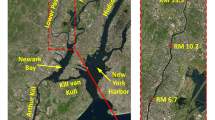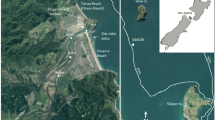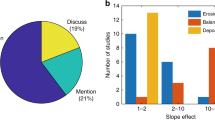Abstract
Estuary evolution is investigated using the hydrodynamic and sediment transport model, Delft3D, to study the response of a dammed tidal basin to restored tidal processes. The development of decadal (10-year) morphological simulations of the restored estuary required simplifying several data inputs and implementing a time-scale acceleration technique. An innovative river sediment discharge schematization was developed that connected sediment discharge to morphological change in the estuary. Mud erodibility parameters were determined from laboratory analysis of sediment cores from the modern lakebed and statistical refinement with a Bayes network of the probability of occurrence. The changing estuary morphology appears to have a dominant impact on the physical habitat (substrate, inundation frequency, mean salinity, and salinity range). The numerical model provides a tool to compare the functions of the historical estuary and possible future alternatives for a restored estuary. Sensitivity of the morphological model to sediment types and erodibility parameters was also examined. A conceptual model covering morphology and indicators of physical habitat for three phases of estuary evolution during restoration is presented that could be applied to estuarine systems that are severely out of equilibrium.














Similar content being viewed by others
References
Cooper, J.A.G. 2002. The role of extreme floods in estuary-coastal behaviour: contrasts between river- and tide-dominated microtidal estuaries. Sedimentary Geology 150: 123–137.
Dalrymple, R.W., B.A. Zaitlin, and R. Boyd. 1992. Estuarine facies models: conceptual basis and stratagraphic implications. Journal of Sedimentary Petrology 62(6): 1130–1146.
Davis, R.A. (ed.). 1978. Coastal sedimentary environments, 413. New York: Springer.
De Vriend H.J., Capobianco M., Latteux B., Chesher T., Stive M.J.F., 1993. Approaches to long-term modelling of coastal morphology: A review. Coastal Engineering 21: 225–269.
Eshleman, J., Ruggiero, P., Kinsley, E., Gelfenbaum, G., and George, D., 2006. Capitol Lake, Washington 2004 data summary. USGS Data Series report.
Friedrichs, C.T., and D.G. Aubrey. 1996. Uniform bottom shear stress and equilibrium hypsometry of intertidal flats, in mixing in Estuaries and Coastal Seas. Coastal and Estuarine Studies 50: 405–429.
Ganju, N.K., N. Knowles, and D.H. Schoellhamer. 2008. Temporal downscaling of decadal sediment load estimates to a daily interval for use in hindcast simulations. Journal of Hydrology 349: 512–523.
Gelfenbaum, G., Roelvink, J.A., Meijs, M., Buijsman, M. and Ruggiero, P. 2003. Process-based morphological modeling of Grays Harbor inlet at decadal timescales. Proceedings of the Coastal Sediments ‘03 International Conference, 13p.
George, D. A., Gelfenbaum, G., Lesser, G., Stevens, A. W. 2006. Deschutes estuary feasibility study—Hydrodynamics and sediment transport modeling. United States Geological Survey Open File Report 2006–1318. 222 pp.
Haff, P.K. 1996. Limitations on predictive modeling in geomorphology. In The scientific nature of geomorphology, ed. B.L. Rhoads and C.E. Thorn, 337–358. New York: Wiley.
Hill, P.S. 1998. Controls on floc size in the sea. Oceanography 11: 13–18.
Jumars, P.A., and A.R.M. Nowell. 1984. Effects of benthos on sediment transport: difficulties with functional grouping. Continental Shelf Research 3: 115–130.
Latteux, B. 1995. Techniques for long-term morphological simulation under tidal action. Marine Geology 126: 129–141.
Law, B.A., P.S. Hill, T.G. Milligan, K.J. Curran, P.L. Wiberg, and R.A. Wheatcroft. 2008. Size sorting of fine-grained sediments during erosion: results from the western Gulf of Lions. Continental Shelf Research 28(15): 1935–1946.
Lesser, G. R. 2010. An approach to medium-term coastal morphological modeling. UNESCO-IHE PhD thesis. UNESCO-IHE Institute for Water Education, Delft, The Netherlands.
Lesser, G.R., J.A. Roelvink, J.A.T.M. Van Kester, G.S. Stelling, and V. Lakhan. 2004. Development and validation of a three-dimensional morphological model. Coastal Engineering 51: 883–915.
Lick, W., Z. Chroneer, C. Jones, and R. Jepsen. 1997. A predictive model of sediment transport. Estuarine and Coastal Modeling 5: 389–399.
Mathews, R., and B.D. Richter. 2007. Application of the indicators of hydrologic alteration software in environmental flow setting. Journal of the American Water Resources Association 43: 1400–1413.
McNeil, J., C. Taylor, and W. Lick. 1996. Measurements of erosion of undisturbed bottom sediments with depth. Journal of Hydraulic Engineering 122: 316–324.
Mih, W., and J. Orsborn. 1974. Sediment removal and maintenance system for the upper basin of Capital Lake Olympia, Washington. Preliminary Report, 33. Pullman: Washington State University.
Partheniades, E. 1965. Erosion and deposition of cohesive soils. Journal of the Hydraulics Division, American Society of Civil Engineers 91: 105–138.
Postma, H., 1967. Sediment transport and sedimentation in the estuarine environment. In Estuaries, ed. G.H. Lauff, 158–179. Washington: AAAS.
Pritchard, D., A.J. Hogg, and W. Roberts. 2002. Morphological modeling of intertidal mudflats: the role of cross-shore tidal currents. Continental Shelf Research 22: 1887–1895.
Roberts, J., R. Jepson, D. Gotthard, and W. Lick. 1998. Effects of particle size and bulk density on erosion of quartz particles. Journal of Hydraulic Engineering 124: 1261–1267.
Roberts, W., P. Le Hir, and R.J.S. Whitehouse. 2000. Investigation using simple mathematical models of the effect of tidal currents and waves on the profile shape of intertidal mudflats. Continental Shelf Research 20(10/11): 1079–1097.
Roelvink, J.A. 2006. Coastal morphodynamic evolution techniques. Coastal Engineering 53: 277–287.
Sanford, L.P. 2008. Modeling a dynamically varying mixed sediment bed with erosion, deposition, bioturbation, consolidation, and armoring. Computers and Geosciences 34(10): 1263–1283.
Simenstad, C., D. Reed, and M. Ford. 2006. When is restoration not? Incorporating landscape-scale processes to restore self-sustaining ecosystems in coastal wetland restoration. Ecological Engineering 26(1): 27–39.
Sondi, I., M. Juracic, and V. Pravdic. 1995. Sedimentation in a disequilibrium estuary: the Rasa River Estuary (Adriatic Sea, Croatia). Sedimentology 42: 769–782.
Soulsby, R.L., L. Hamm, G. Klopman, D. Myrhaug, R.R. Simons, and G.P. Thomas. 1993. Wave–current interaction within and outside the bottom boundary layer. Coastal Engineering 21: 41–69.
Spiegelhalter, D.J., A.P. Dawid, S.L. Lauritzen, and R.G. Cowell. 1993. Bayesian analysis in expert systems. Statistical Science 8: 219–293.
Stevens, A.W., R.A. Wheatcroft, and P.L. Wiberg. 2007. Seabed properties and sediment erodibility along the western Adriatic margin. Italy: Continental Shelf Research 27: 400–416.
Stevens, A.W., Gelfenbaum, G., Elias, E., Jones, C., 2008. Incorporation of fine-grained sediment erodibility measurements into sediment transport modeling, Capitol Lake, Washington. US Geological Survey Open-File Report 2008–1340, 72 p.
Uncles, R.J. 2002. Estuarine physical processes research: some recent studies and progress. Estuarine, Coastal and Shelf Science 55: 829–856.
van der Wegen, M., A. Dastgheib, B.E. Jaffe, and D. Roelvink. 2010. Bed composition generation for morphodynamic modeling: case study of San Pablo Bay in California, USA. Ocean Dynamics 61(2–3): 173–186.
van der Wegen, M., B.E. Jaffe, and D. Roelvink. 2011. Process–based, morphodynamic hindcast of decadal deposition patterns in San Pablo Bay, California, 1856–1887. Journal of Geophysical Research 116: F02008. doi:10.1029/2009JF001614.
van Rijn, L. 1993. Principles of sediment transport in rivers, estuaries, and coastal seas, 715. Amsterdam: Aqua.
Wheatcroft, R.W., and C.A. Butman. 1997. Spatial and temporal variability in aggregated grain-size distributions, with implications for sediment dynamics. Continental Shelf Research 17: 367–390.
Williams, P.B., M.K. Orr, and N.J. Garrity. 2002. Hydraulic geometry: a geomorphic design tool for tidal marsh channel evolution in wetland restoration projects. Restoration Ecology 10(3): 577–590.
Wood, R., and J. Widdows. 2002. A model of sediment transport over an intertidal transect, comparing the influences of biological and physical factors. Limnology and Oceanography 47: 848–855.
Acknowledgments
This work was part of a large collaborative process, and we would like to acknowledge the contributions of the Deschutes Estuary Feasibility Study Technical Committee, including Curtis Tanner, Steven Morrison, and Nathaniel Jones. Giles Lesser was instrumental in developing the morphological modeling techniques. We thank Edwin Elias, Jodi Eshleman, and Bert Jagers for their assistance in executing the project. We thank George Tate and Craig Jones for help collecting cores and performing SedFlume analysis. Nathaniel Plant provided guidance in applying the Bayesian model to the erodibility data. The manuscript was greatly improved by input from Jessica Lacy, Greg Hood, Neil Ganju, and an anonymous reviewer. This project was funded by the Salmon Recovery Funding Board (SRFB), the Washington Department of General Administration, the Puget Sound Action Team, the Port of Olympia, and the US Geological Survey Coastal and Marine Geology Program. We thank our friends and colleagues for their support during this multiyear effort.
Author information
Authors and Affiliations
Corresponding author
Appendix
Appendix
Cross-Section Transects Used in Sensitivity Analysis to Sediment Grain Size
Rights and permissions
About this article
Cite this article
George, D.A., Gelfenbaum, G. & Stevens, A.W. Modeling the Hydrodynamic and Morphologic Response of an Estuary Restoration. Estuaries and Coasts 35, 1510–1529 (2012). https://doi.org/10.1007/s12237-012-9541-8
Received:
Revised:
Accepted:
Published:
Issue Date:
DOI: https://doi.org/10.1007/s12237-012-9541-8













